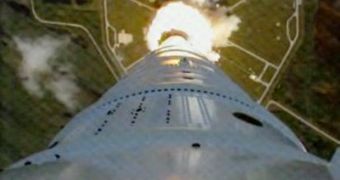In late October, NASA's new rocket prototype, the ARES I-X, blasted off from the renewed Launch Pad 39B, at the Kennedy Space Center (KSC), in Florida. Aimed at testing the engines that would go on the ARES I delivery system, the flight was mainly a success, apart from a parachute glitch at the end, which saw the recoverable first stage getting a large dent in it. But the test was also made possible by the rocket's roll control system, which is basically a collection of nozzles that spit jets in a number of directions, according to needs, Space Fellowship reports.
The thing about launching a 325-foot-tall rocket is that you don't have too many options at steering it precisely during ascent. Excess vibrations can cause the machine to break apart in either case, but you also need to be able to control how it moves and rolls through the air as it climbs. The American space agency resorted to the help of a collection of roll control thrusters. These equipments started functioning as soon as the rocket cleared the ramp, and only ceased operations when the first stage separation took place. NASA experts say that their actions were instrumental to the success of the test flight.
The costs and intensive labor associated with constructing this auxiliary system were reduced by using parts from decommissioned Peacekeeper missiles. The latter were to be destroyed by the US Air Force (USAF), as part of the Strategic Arms Reduction Treaty (START II), which was signed by the US and Russia in 1993, to ban the deployment of multiple, individually targetable warheads (MIRV) on Intercontinental Ballistic Missiles (ICBM). In addition, parts from the space shuttles were also used, to further improve cost forecasts and work times.
“For the Ares I, vehicle control will be somewhat similar to an airplane. On an airplane, roll control is accomplished with the ailerons – hinged flaps on the wings – that keep the wings level with the horizon. From liftoff to first-stage separation, roll control for Ares I will be accomplished by firing the first-stage roll control system thrusters,” Reaction Control System Subsystem Manager Phillip Best says. He works at the NASA Marshall Space Flight Center Ares I Upper Stage Office. Keeping the ARES I and I-X in their correct flying positions is extremely important.
This will provide astronauts with a steady sense of direction, allowing them to report to the horizon line, and will also maintain the rockets' antennas in the correct position for relaying back vital telemetry to ground stations. Engineers estimate that the nozzle systems will have to compensate for two things – roll torques (which are produced by forces trying to spin the rocket around its axis) and external factors such as winds. Plans are to overcome these dangers by using two thruster modules, with six thrusters each. They will produce a combined thrust of 1,250 pounds of force per module, more than enough to ensure a steady flight.

 14 DAY TRIAL //
14 DAY TRIAL //